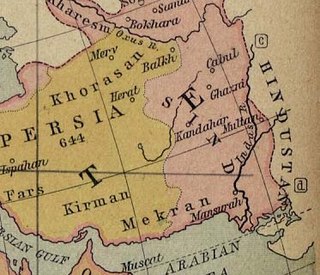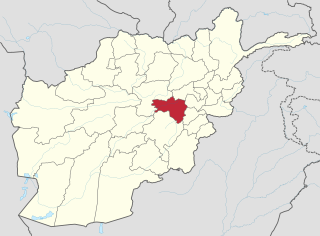
Babur, born Zahīr ud-Dīn Muhammad, was the founder of the Mughal Empire and first Emperor of the Mughal dynasty in the Indian subcontinent. He was a descendant of Timur and Genghis Khan through his father and mother respectively. He was also given the posthumous name of Firdaws Makani.

The Bāburnāma is the memoirs of Ẓahīr-ud-Dīn Muhammad Bābur (1483–1530), founder of the Mughal Empire and a great-great-great-grandson of Timur. It is written in the Chagatai language, known to Babur as Türki "Turkic", the spoken language of the Andijan-Timurids. During the reign of emperor Akbar, the work was translated into Persian, the usual literary language of the Mughal court, by a Mughal courtier, Abdul Rahim Khan-i-Khanan, in AH 998.
Qutlugh Nigar Khanum was the first wife and chief consort of Umar Shaikh Mirza II, the ruler of Ferghana Valley. She was a princess of Moghulistan by birth and was a daughter of Yunus Khan, the Great Khan of Moghulistan.

In 1504 Babur besieged Kabul and took the city from the Arghuns under Mukim Beg Arghun to become the new king of Kabul and Ghazni regions. The territory gave him respite from his Uzbek troubles in Central Asia and allowed him to build his nascent kingdom into a strong and formidable power in later years, enough to be able to conquer northern India.

After the death of King Abu Sa'id Mirza, the great-grandson of Amir Timur Beg Gurkani, his much reduced Timurid Empire was divided among four of his sons namely;

In the early 16th century, Sultan Mahmud Khan, the Chagatai Khan of Western Moghulistan, and Sultan Ahmad Alaq Khan, the Chagatai Khan of Eastern Moghulistan, decided to counter the growing power of the Uzbeks under Muhammad Shaybani. Sultan Ahmed Tambol had rebelled against his Timurid master Babur and declared his independence. But when Babur tried to reconquer his territory with the help of his uncles, Ahmed Tambol sought the assistance of the Uzbeks. The two Moghul brothers united their forces and launched a campaign against Tambol, but Muhammad Shaybani surprised the Khans and proved victorious in battle of Akhsi and took them both prisoner.
Eastern Afghanistan Operations was when Uzbek Khan and Muhammad Shaybani surrounded Kandahar, Babur found his developing Kingdom of Kabul in danger. He feared that Kabul would be the next target of the Uzbeks. Having consulted with his men, he decided the only way out was to leave to India. Babur's second Indian expedition, became an operation monitoring Kabul, traveling around eastern provinces of Afghanistan to subdue rebellious Afghans and plunder towns and villages for supplies for his army's survival.

After the conquest of Kabul, Babur had imposed a large contribution of horses and sheep on the Sultan Masudi Hazaras and sent collectors to receive it. However, his collectors returned unsuccessful. The Hazaras refused to pay as they did not recognize Babur as their legitimate sovereign. Several times before they had been guilty of depredations on the roads of Ghazni and Gardez. Babur decided to subdue the Hazaras in what is now Maidan Wardak Province of Afghanistan.

Umar Shaikh Mirza II was the ruler of the Fergana Valley. He was the fourth son of Abu Sa'id Mirza, the Emperor of the Timurid Empire in what is now Kazakhstan, Uzbekistan, Afghanistan and eastern Iran.
Babur had planned an expedition against Kandahar in 1506, which was governed by Shah Shuja better known as Shah Beg Arghun. Babur had marched towards Shniz where Wardak Afghans were residents. He had not decided yet whether or not to proceed against Kandahar when he held a war council in which his brother Jahangir Mirza II and Baqi Cheghaniani suggested instead of taking Qalati Ghilji. Qalati Ghilji was bestowed on Mukim Beg Arghun by his father Dhul-Nun Beg Arghun. Mukim's partisans, Farrukh Arghun and Kara Bilut, held it at this time on his part. On reaching Tazi, Sher Ali Chihreh and Kuchek Baqi Dewana, with some others, had formed the plan of deserting. Babur instantly had them seized, Sher Ali Chihreh was executed, having deprived the others of their arms and horses, he let them go.

Abu'l-Nasir Muhammad, better known by the sobriquet Hindal, was a Mughal prince and the youngest son of Emperor Babur, the founder of the Mughal Empire and the first Mughal emperor. He was also the older brother of Gulbadan Begum, the younger half-brother of the second Mughal emperor Humayun, as well as the paternal uncle and father-in-law of the third Mughal emperor Akbar.
The First Campaign against Turkomen Hazaras was a Mughal Empire campaign against Hazaras in the 16th century. Following Babur's departure from Kabul for Qalat, the Hazaras took advantage of his absence to raid his territories. After Babur had returned to Kabul from his victory at the Battle of Qalat, he remained encamped in the Chaharbagh during the harsh winter of 1505 CE where he planned to make an excursion against them. He then went into Kabul city into the palace of Ulugh Beg Mirza, called Bostān-Serāi, prepared for the campaign and set out from there on December 28, 1505 CE.
Aisha Sultan Begum was Queen consort of Ferghana Valley and Samarkand as the first wife of Emperor Babur, the founder of the Mughal Empire and the first Mughal emperor.

Khanzada Begum was a Timurid princess and the eldest daughter of Umar Shaikh Mirza II, the amir of Ferghana. She was also the elder sister of Babur, the founder of the Mughal Empire. She and her brother remained deeply attached to each other all their lives, a period during which the family progressed from ruling a tiny and obscure principality in Central Asia to ruling a large portion of the Indian subcontinent. Babur conferred on his sister, the honorable title of Badshah Begum and she was really the first lady of his Empire after his death.

Aisan Daulat Begum was the Queen consort of Moghulistan as the first wife and chief consort of Yunus Khan, a descendant of Chaghatai Khan, the second son of Genghis Khan. She was the mother of Qutlugh Nigar Khanum, and hence the grandmother of the first Mughal emperor, Babur.
Masuma Sultan Begum was the Queen consort of Ferghana Valley and Samarkand as the fourth wife of Emperor Babur, the founder of the Mughal Empire and the first Mughal emperor.
Mihr Nigar Khanum was the first wife of Sultan Ahmed Mirza, the King of Samarkand and Bukhara. She was a princess of Moghulistan by birth and was the eldest daughter of Yunus Khan, the Great Khan of Moghulistan and his chief consort Aisan Daulat Begum. She was also the aunt of Emperor Babur, the founder of the Mughal Empire of India as well as its first Emperor.
Zainab Sultan Begum was Queen consort of Ferghana Valley and Kabul as the second wife of the first Emperor Babur. She like two of his other wives Aisha Sultan Begum and Masuma Sultan Begum was a direct cousin of the Babur.
Masuma Sultan Begum was a Mughal princess and the daughter of the first Mughal emperor, Babur. She is frequently mentioned in the Humayun-nama by her sister, Gulbadan Begum, who calls her sister 'Elder sister Moon'.
Jahangir Mirza II was the second son of Umar Sheikh Mirza and younger half-brother of Babur, the founder of the Mughal Empire. He was two years younger to Babur and his mother, Fatima Sultan, belonged to the clan of Mughal Tuman Begs. in 1504 Babur appoint him ruler of Ghazni.









